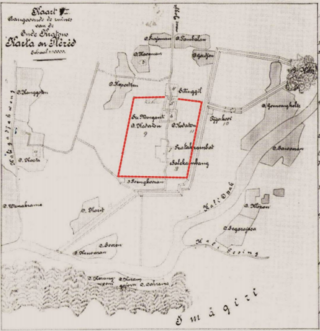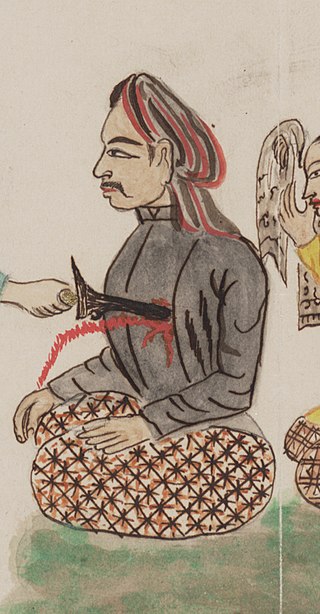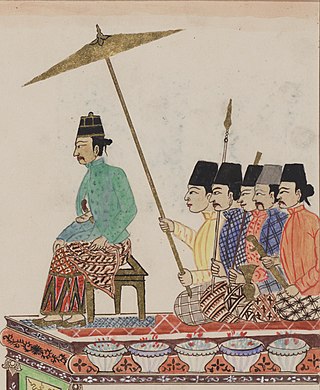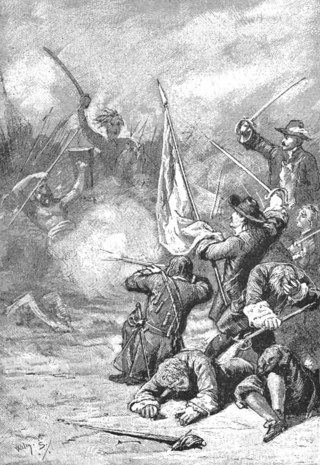
The Sultanate of Mataram was the last major independent Javanese kingdom on the island of Java before it was colonised by the Dutch. It was the dominant political force radiating from the interior of Central Java from the late 16th century until the beginning of the 18th century.

Amangkurat I was the susuhunan of the Mataram Sultanate from 1646 to 1677.

Amangkurat II was the susuhunan of the Sultanate of Mataram from 1677 to 1703. Before taking the throne, he was the crown prince and had the title Pangeran Adipati Anom.

Plered was the location of the palace of Amangkurat I of Mataram (1645–1677). Amangkurat moved the capital there from the nearby Karta in 1647. During the Trunajaya rebellion, the capital was occupied and sacked by the rebels, and Amangkurat died during the retreat from the capital. His son and successor Amangkurat II later moved the capital to Kartasura. It was twice occupied by Diponegoro, during the Java War (1825–1830) between his forces and the Dutch. The Dutch assaulted the walled complex in June 1826, which was Diponegoro's first major defeat in the war.

Untung Suropati also Untung Surapati was a warfighter in the East Indies who led a few rebellions against the Dutch East India Company (VOC). Some of his exploits were written in Babad Tanah Jawi.
The First Javanese War of Succession was a struggle between Sultan Amangkurat III of Mataram and the Dutch East India Company who supported the claim of the Sultan's uncle, Pangeran Puger to the throne.

Trunajaya (Madurese) or Tronajâyâ, also known as Panembahan Maduretno, was a prince and warlord from Arosbaya, Bangkalan, Madura, known for leading the Trunajaya rebellion (1674–1681) against the rulers of the Mataram Sultanate on the island of Java.

Pakubuwono I, uncle of Amangkurat III of Mataram was a combatant for the succession of the Mataram dynasty, both as a co-belligerent during the Trunajaya rebellion, and the First Javanese War of Succession (1704–1707).

Amangkurat III was a short-lived susuhunan (ruler) of the Sultanate of Mataram, who reigned 1703–1705.

The Trunajaya Rebellion or Trunajaya War was the ultimately unsuccessful rebellion waged during the 1670s by the Madurese prince Trunajaya and fighters from Makassar against the Mataram Sultanate and its Dutch East India Company (VOC) supporters in Java.

The Battle of Surabaya was fought in May 1677 during the Trunajaya rebellion, in which the Dutch East India Company defeated the forces of Trunajaya and took Surabaya on behalf of its ally, the Mataram Sultanate.
The Battle of Gegodog took place on 13 October 1676 during the Trunajaya rebellion, and resulted in the victory of the rebel forces over the Mataram army led by the Crown Prince Pangeran Adipati Anom. Gegodog is located on the northeastern coast of Java, east of Tuban.
After his victory at the Battle of Gegodog in northeast Java, the Madurese rebel leader Trunajaya proceeded westwards to conquer Mataram Sultanate's remaining towns on the north coast of Java
Pangeran Pekik was a Javanese prince, and son of the last Duke of Surabaya, Jayalengkara. After the Mataram conquest of Surabaya, he was forced to live in Mataram court. He was executed in 1659 on the orders of Mataram's King Amangkurat I, who suspected him of conspiracy.
Raden Kajoran, also Panembahan Rama was a Javanese Muslim nobleman and a major leader of the Trunajaya rebellion against the Mataram Sultanate. He led the rebel forces which overran and sacked Plered, Mataram's capital in June 1677. In September 1679, his forces were defeated by the combined Dutch, Javanese, and Bugis forces under Sindu Reja and Jan Albert Sloot in a battle in Mlambang, near Pajang. Kajoran surrendered but was executed under Sloot's orders.
I Maninrori Kare Tojeng, also known as Karaeng Galesong, was a Makassarese nobleman and warrior, and a major leader of the Trunajaya rebellion in Java against the Mataram Sultanate. He participated in the successful invasion of East Java and the subsequent rebel victory at Battle of Gegodog (1676). He later fell out with Trunajaya, and built a stronghold in Kakaper, East Java. Dutch East India Company (VOC) and Bugis forces took Kakaper in October 1679, but Galesong escaped and rejoined Trunajaya. He died on 21 November 1679, either by illness or murdered by Trunajaya, before the rebellion ended.

In a campaign that took place from August to December 1678 in Kediri during the Trunajaya rebellion, the forces of the Mataram Sultanate, led by Amangkurat II, and of the Dutch East India Company (VOC), led by Anthonio Hurdt, marched inland into eastern Java against Trunajaya's forces. After a series of marches beset by logistical difficulties and harassment by Trunajaya's forces, the Mataram–VOC army crossed the Brantas River on the night of 16–17 November. They then marched on Trunajaya's capital and stronghold at Kediri and took it by direct assault on 25 November. Kediri was plundered by the Dutch and Javanese victors, and the Mataram treasury—captured by Trunajaya after his victory at Plered—was completely lost in the looting. Trunajaya himself fled Kediri and continued his greatly weakened rebellion until his capture at the end of 1679.
Hermanus Johannes de Graaf was a Dutch historian specialising in the history of Java, Indonesia, the world's most populous island. Trained as historian at Leiden University, he moved to Batavia to take a government job, and later became a teacher for various schools in Indonesia. At the same time, he pursued his interest in the history of Indonesia and published books and articles on the topic. After a brief assignment at the University of Indonesia, he returned to the Netherlands. He taught at various institutions, including Leiden, until 1967 and continued to publish scholarly works, even after his retirement. He suffered a serious stroke in 1982 and died two years later.
Anthonio Hurdt was a Dutch East India Company (VOC) officer active in what is now Indonesia in the seventeenth century. He was initially assigned in civilian positions in Eastern Indonesia, the latest of which was the VOC Governor of Ambon. He was then posted to Java—in Western Indonesia—to lead the Kediri campaign against Trunajaya. After a protracted march slowed by logistical challenges, VOC and its ally Mataram overran Trunajaya and took his stronghold and court at Kediri, 25 November 1678. After the campaign he served in Batavia, becoming Director-General of the VOC in the Indies from 1684 to 1687, when he was expelled due to a dispute with Governor-General Joannes Camphuys.

François Tack was a Dutch East India Company (VOC) officer. Ranked captain at the time of his death, he was one of the VOC's main commanders during the 1678 Kediri campaign against Trunajaya and participated in the city's assault. He was later killed during a brawl at the court of Mataram in Kartasura on 8 February 1686, where he was sent on a diplomatic mission to arrest Untung Surapati.














